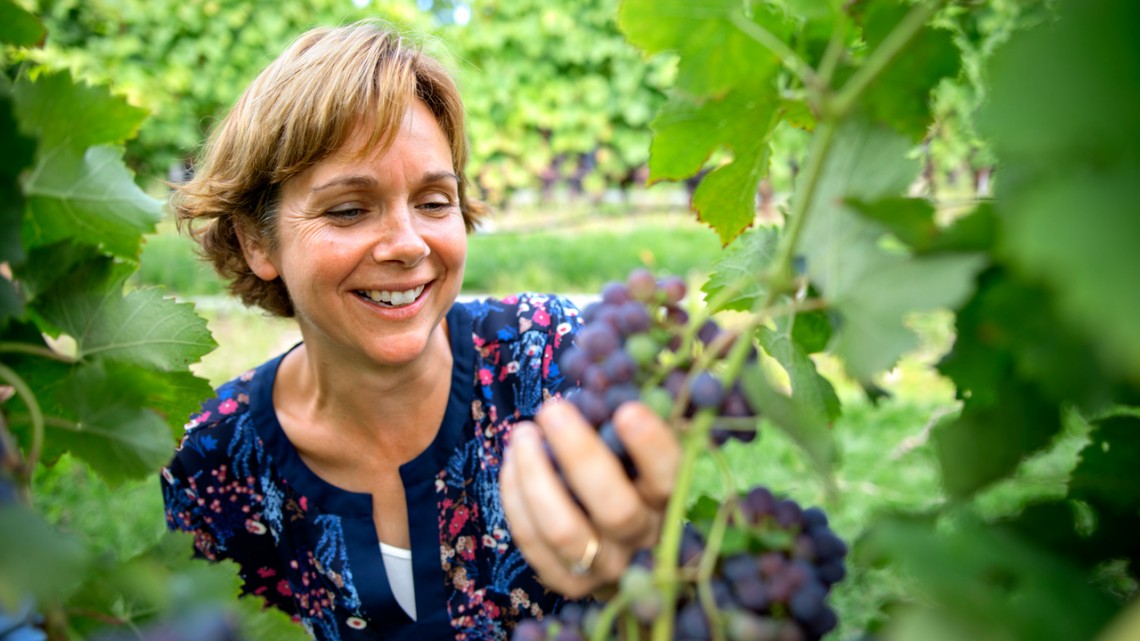
Justine Vanden Heuvel, associate professor of horticulture, examines grapes growing at the Cornell Orchards in Lansing, New York.
Digital agriculture workshop highlights radical collaborations
By Krisy Gashler
For grape growers, accurately predicting each season’s yield is key to a successful harvest. Underpredict, and you won’t have enough labor on hand or you’ll run out of storage space; overpredict, and you could fall through on promises to your distributors.
Two Cornell researchers are tackling the age-old problem using 21st century tools: inexpensive, touch-sensitive soft robots that can help growers predict yield and detect fungal threats.
Justine Vanden Heuvel, associate professor of horticulture in the College of Agriculture and Life Sciences (CALS), researches strategies to help grape growers improve their environmental and economic sustainability. Kirstin Petersen, assistant professor of electrical and computer engineering, studies bio-inspired and soft robotics.
The researchers were brought together through the Cornell Initiative for Digital Agriculture (CIDA), which was founded in 2017 for the purpose of initiating these kinds of radical collaborations across disciplines to solve the biggest problems in agriculture and food systems.
Petersen and Vanden Heuvel’s collaboration was one of six digital agricultural projects funded by an initial round of USDA Hatch grants in 2017. Another nine projects were funded in 2019 through the CIDA Research Innovation Fund. All of the Cornell researchers, along with industry, nonprofit and governmental stakeholders, will come together on Oct. 30 for the Third Annual CIDA Digital Agriculture Workshop.
Tim Vanini ’91, managing director of CIDA, said the initiative hopes to address the factors that will enable our global food systems to feed 10 billion people by 2050. That includes improving efficiency and sustainability; mitigating environmental impacts; reducing food waste; protecting food safety; and possibly developing new socioeconomic models.
“Agriculture is the last major industry sector to move into the digital age,” Vanini said. “We need professors from software programming and design, robotics and system analytics to be brought into the agricultural system, and we need those people partnered with the plant and soil scientists, entomologists, pathologists and food safety experts who know what the problems are and where solutions need to be deployed.”
With support from USDA funding, CIDA awards grants to promising digital agriculture projects as seed money, providing resources for researchers to begin growing their projects from a seed of inspiration, in the hope that some of the projects will bear fruit.
“There are certain challenges in working with colleagues in other fields. We speak past each other sometimes,” Petersen said. “But it’s also an incredible collaboration. There are no boundaries, because the person you’re working with is not aware of the boundaries that exist in your discipline – they can see beyond those, and it helps open your mind to see beyond them, too.”
Petersen and Vanden Heuvel’s project is a perfect example of what CIDA wants to accomplish, Vanini said. After their initial work, the team was able to apply for and receive a $1.19 million grant from the National Institute of Food and Agriculture to keep developing their ideas and eventually test them in working vineyards.
Other researchers have used sophisticated and expensive cameras to predict grape yield late in the season, Petersen said. This method works well in areas with smaller vines and limited foliage, like Napa Valley, California, but it’s less effective in areas like New York state, with its heavy rainfall and vigorous vegetative growth that can block a camera’s view of grape clusters.
However, with their combined expertise in plant growth and machine learning, the researchers realized that they could predict yield very early in the season, when the flower clusters first emerge.
“There’s a specific cohesion about how the leaves grow and where the clusters appear,” Petersen said. “Before berries even form, we can go out and do this with something as simple as a smartphone and a flashlight, which is incredible.”
Their method gives growers more time to plan and is more affordable than existing technologies.
In another project, Vanden Heuvel and Petersen are collaborating with Amit Lal, professor of electrical and computer engineering, to develop soft robots armed with high-resolution sensors. These sensors perform ultrasounds on the growing grapes that can detect things like differences in sugar content, berry firmness and fungal spores such as dreaded pathogens downy mildew and powdery mildew.
“Our work to improve vineyard management strategies keeps New York state’s $4.8 billion wine and grape industry thriving,” said Kathryn J. Boor ’80, the Ronald P. Lynch Dean of CALS. “Our research collaborations in digital agriculture allow Cornell to leverage its unparalleled strengths at the intersection of agriculture, business, engineering and information science.”
Krisy Gashler is a freelance writer for the College of Agriculture and Life Sciences.
Media Contact
Get Cornell news delivered right to your inbox.
Subscribe

